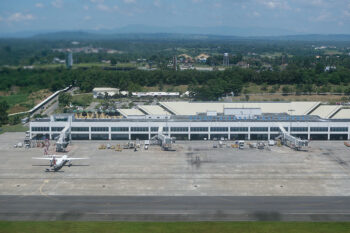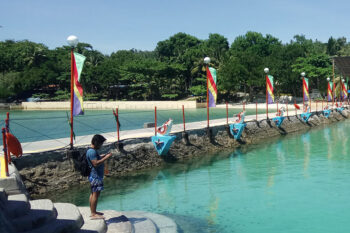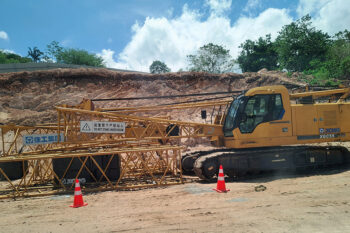GENERAL SANTOS CITY (MindaNews / 23 Jan) – On Saturday, Mayor Darlene Antonino Custodio led city officials and families of fishermen in honoring those who perished and went missing during the height of super typhoon Pablo.
It was an emotional voyage for all who joined the ceremony.
The city mayor was so distraught she reportedly shed tears.
For the families still hoping their loved ones are still alive, it was a voyage to eventuality.
Yes, all 352 fishermen still listed as missing may have already died in the open seas that ironically sustained them in life.
They were part of the 378 fishermen from General Santos City alone who were caught in the middle of a perfect storm – one that nobody from their class could have imagined. Except for the 18 survivors who lived to tell their harrowing ordeals.
When Pablo violently raced through the Pacific Ocean and headed to the eastern coasts of Mindanao, the owners of the fishing vessels hoped their fishing crews were able to find refuge and seek shelter from the destructive wrath of the super typhoon.
When all was over, all they could locate was their vessels’ last known GPS locations based on last radio contact.
One fishing company owner recalled how their base operator had heard hoarse and fainting voices from fishermen frantically crying for help before these were followed by complete radio silence.
In the aftermath, veteran journalist and former New York Times reporter Mort Rosenblum asked why these vessels could not be tracked when they are supposed to be equipped with vessel monitoring system (VMS) as required by the convention on conservation measures (CCM) of the Western and Central Pacific Fisheries Commission (WCPFC).
The Philippines is a member of WCPFC.
Rosenblum was at the 9th WCPFC meeting in Manila on December 2 to 6 when tragedy struck.
Pablo hit landfall in Davao Oriental on December 3.
Rosenblum went straight to General Santos City after the meeting only to be aghast why these vessels do not have VMS equipment when they are supposed to have one to comply with the WCPFC rules and policies.
Dino Barrientos, executive director of the Umbrella Fish Landing Association (UFLA), admitted all 51 fishing vessels that went missing were not equipped with VMS although he said they have a complement of communications equipment such as VHF-UHF, single side band and citizen’s band radios and GPS kit.
These communication equipment are however vulnerable to weather elements and could conk out when washed out in sea water. A break and malfunctioning of the antenna could cut them off from their home bases.
Costly lessons
Barrientos said a VMS costs anywhere between P100,000 to P180,000.
“For the two-way system. It does not include air time fee,” Barrientos said.
ROM Communications said its ROMTraX VMS-9601 units’ pricing starts at US$1,374, excluding backup battery module.
“(B)ut can be higher if additional features are chosen. Savings can be achieved with volume purchasing,” its website said.
To register, a fishing company has to pay US$50 per month for each unit for the base plan only. For hourly positioning, a vessel owner will have to shell out US$85 per month. If one wants a 15-minute reporting, the vessel owner will have to cough up US$160 per month.
The UK-based Seafish said installing a VMS could reach £8,744 for a three-year coverage, installation and frequency rate every five minutes. That is roughly P550,000 for the duration or P183,000 per vessel per year.
But Dexter Teng, operations officer of TSP Marine Industries, said fees will depend on the satellite provider/server.
“Fees should not be expensive but the number of poles (where the VMS onboard sends positional and other data to server) … those are expensive. It will depend on how many poles per day,” Teng said.
According to ROM Communications, “A VMS unit is about the size of a small radio with an antenna. Data is sent to a satellite orbiting the earth, relayed to a station on the ground and then sent to the designated vessel-monitoring centre in near real time or at a pre-determined time intervals.
“VMS units are available with a backup battery that allows it to continue to operate in the event of a vessel power failure.”
The VMS is often referred to as the blue box of fishing vessels.
However, it does not have the standard transponder of the black boxes of airplanes that will send signal of its location in case of a plane crash.
But its backup battery could help rescuers in the event of mishaps and distress calls in the open seas.
Barrientos however said not all Philippine fishing fleet could afford to install a VMS on their vessels.
One Philippine tuna fishing fleet consists of a catcher vessel, four to five light boats and at least a fish carrier.
But Teng said the WCPFC should also address compatibility of VMS and how it works with different systems.
“These are issues that WCPFC will have to resolve,” he said.
VMS was primarily designed to monitor the location of fishing vessels in relation to the origin of their catches.
With growing concerns over dwindling tuna stocks, the WCPFC agreed to several conservation measures, including closing some pockets of high seas to tuna fishing during specific periods of the year.
The VMS is supposed to discourage illegal and unauthorized fishing in the high seas as well as regulate fishing activities in exclusive economic zones and municipal waters of WCPFC member countries
Looking back, Teng said the VMS could have helped them track, in real time, the location of their fishing vessels in relation to the path of Pablo.
“Combined with robust weather and distress monitoring system, we could have saved the lives of our fishermen,” Teng said.
Dead of the night
Marfenio Tan, former president of the Socsksargen Federation of Fishing and Allied Industries (SFFAI), said most base radio communications of fishing companies are turned off during the night, which explains why many distress calls may have gone unheard.
But it may also have not mattered at all.
Pablo (international code name Bopha) was one of the strongest typhoons to hit the country in recent years.
With sustained winds of up to160 mph (260 km/h), Pablo wrought havoc unseen in Mindanao for decades.
“It was the first time our fishermen encountered a perfect storm,” Tan said.
Inland, Pablo flattened coconut trees and chopped banana plantations like a lawnmower. It left in its path more than 1,000 dead and over 800 missing. At least P17 billion (US$415 million) in properties, infrastructure and crops were damaged when it was all over. Some towns in Compostela Valley and Davao Oriental are yet to go over with the tragedy with rehabilitation at least more than a couple years ahead.
The tuna industry in General Santos City said it sustained more than P640 million losses in lost vessels alone.
In the aftermath, Tan said it is essential for companies to regularly monitor the weather as well as location of their fishing vessels.
An avid game fishing enthusiast, Tan is no stranger to the elements of the weather. He continuously monitors the weather situation in the open seas and raises the red flag at the slight swelling of the seas and difference in height of waves.
Tan, a reserve commodore in the Philippine Navy, said the change of direction of Pablo may have also contributed to the unprecedented high number of fishermen casualties.
Pablo was predicted to hit landfall in Surigao del Sur but it veered several degrees downward at the very last minute, hitting with full might Baganga town in Davao Oriental on December 3.
Montgomery Montealegre said he escaped Pablo when he left their catcher vessel on November 30, a day ahead of schedule. He said the catcher boat was at coordinates 09-129, some 302 kilometers off Baganga, when he left for shore.
They were already moored in Mati, Davao Oriental on December 2 when Pablo hit landfall. His son Mark Gil was supposed to follow him on board a catcher vessel the following day. Mark Gil never made it to Mati. He is among the 109 still missing fishermen from LPS Fishing which suffered the most number of fishermen lost in thigh seas and the most number of fishing vessels (15), including 3 catcher boats.
Dominic Salazar of Thidcor Fishing said its catcher vessel FB Queen Mary sent its last radio message on December 3 at coordinates 07-53-75, 128-22-38 and 07-50-13, 128-25-54. The Philippine Navy said the location was 198 kilometers east of Baganga Point, right in the eye of Pablo. Sailing at a speed of 12 knots per hour, FB Queen Mary would have reached Baganga in 10 hours. But by then, it would have been too long and too late.
On board FB Queen Mary were 19 fishermen who are now presumed dead. Three of the crew members of one of its light boat complement were found alive. The other crew member was swallowed by the seas.
The tuna federation here however said VMS and other communications equipment alone will not guarantee saving the lives of fishermen in distress situation.
The tuna industry and the city government do not have statistics on the number of fishermen who were lost in the seas. That could top over a thousand over the years. They now have a number to start with.
But Teng said the Pablo tragedy should also spur the government into investing in live-saving search and rescue assets.
“A dedicated search and rescue (S&R) assets or two that are on call during bad weather conditions and in cases of distress calls,” Teng explained.
If anything, industry sources said, Pablo exposed the inability of the Philippine government to respond to distress call and to launch massive search and rescue operations “without endangering the lives of rescuers.”
SFFAI also said it will ask for government help in putting up a “robust” weather monitoring system that can alert fishermen on incoming weather disturbance.
Most fishing industries are relying on websites that are tracking weather patterns around the globe.
This may be a tad too late for the fishing companies who lost their fishermen and fishing vessels. But at least the painful Pablo tragedy taught them that caution and erring on the side of safety are now primordial concerns in dealing with similar incidents in the future. (Edwin G. Espejo writes for www.asiancorrespondent.com.)







